Rehabilitation Program: Visual Attention
Click to try FREE for 15-Days.
This module contains exercises designed to train visual attention. In particular, patients need to pinpoint relevant information, visually scan details and keep mind focused on looking for differences.
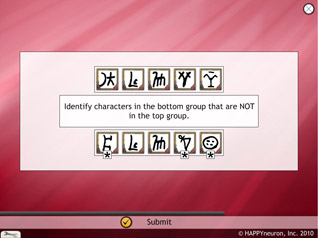
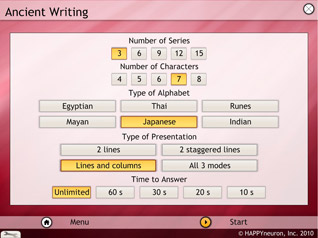
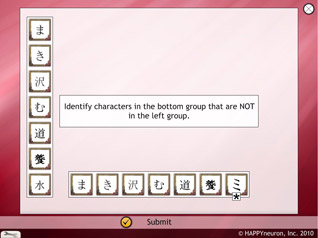
Ancient Writing
The task
In this exercise, the patient must pay close attention to two sets of characters. His task is to distinguish on the second set the characters that are different from the first set of characters.
What it trains
This exercise primarily stimulates the user's visual attention and his concentration skills. Indeed, he will have to pinpoint relevant information (differences), visually scan details and keep his mind focused on looking for differences. Whenever a person is presented with a new set of symbols, such as when learning to navigate traffic signs for the first time or when learning a language with a unique alphabet, he/she uses the skills from this activity.
Parameters
The parameters that can be selected are the number of sequenced series (3, 6, 9, 10, or 15), the number of characters (4, 5, 6, 7, 8, 9, or 10), the type of alphabet (Egyptian, Thai, Runes, Mayan, Japanese, or Indian), the type of presentation (2 lines, 2 staggered lines, lines and columns, or all 3 modes), and the response time (unlimited, 60, 30, 20, or 10 seconds).
Number of Unique Configurations
3,000 unique game configurations and significant data set depth.


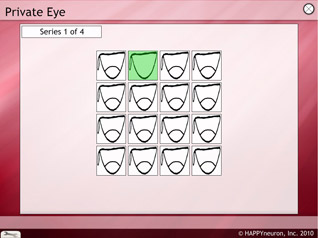
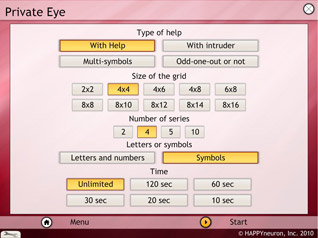
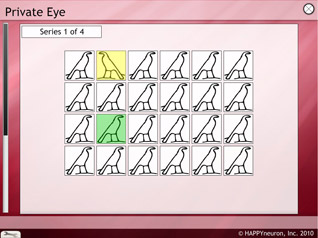
Private Eye
The task
In this task, the patient needs a discriminating eye to locate a symbol in a grid full of intricate symbols and letters (intruder) that differs from other symbols (all of which are identical), and catch the sneaky suspect that was shown before starting the task.
What it trains
Primarily, this task exercises the user's abilities for a specific type of attention called sustained attention and concentration. Attention is the essence of focus and the user will need to focus on looking for a specific target and ignore the symbols that could distract his attention. Any time a person pays attention to something, and any time he ignores something, data is created in his brain. That data has value, but only if it's gathered, measured, and analyzed. In addition, this exercise requires good visual scanning and shape recognition skills.
Parameters
The parameters that can be selected are the type of help (with help, with intruder, multi-symbols, or odd one out, or not), the size of the grid (2x2, 4x4, 4x6, 4x8, 6x8, 8x8, 8x10, 8x12, 8x14, or 8x16), the number of sequenced series (2, 4, 5, or 10), the types of character (letters and numbers or symbols), and the response time (unlimited, 120, 60, 30, 20, or 10 seconds).
Number of Unique Configurations
Over 1,900 unique game configurations and significant data set depth.



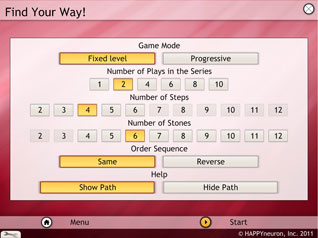
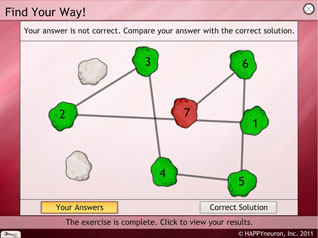
Find Your Way!
The task
This exercise requires to reproduce an itinerary. A trail made up of stones will light up at random and the path it creates has to be memorized. It then has to be recalled in the same or in reverse order. To ease the memorization process help may be given by showing the path of the stones.
What it trains
The skills called upon in this exercise are constantly used in our daily lives. For example, finding shortcuts and new routes between familiar places, retracing our steps through the house to look for our keys or going through a parking lot because it's impossible to remember where the car was parked. Taxi drivers in cosmopolitan cities like New York are a good example of people who have excellent spatial memory and navigation skills. They must learn a large number of places, and know the most direct routes between them. For this task, the main brain structure at work is the hippocampus. The hippocampus is located in the medial temporal lobe. It forms a part of the limbic system and plays a part in long-term memory and spatial navigation, more specifically, in storing and processing spatial information. Without a fully functional hippocampus, humans may not successfully remember where they have been and how to get where they are going. This exercise remediates visual working memory and short-term memory skills.
Parameters
The parameters that can be selected are the game mode (fixed level or progressive), the number of series (1, 2, 4, 6, 8 or 10), the number of stimuli (from 2 to 12), the number of stones (from 2 to 12), the restitution order (same or reverse), and whether there is some help (path is displayed) or not.
Number of Unique Configurations
Over 2100 unique game configurations and significant data set depth.


Click to try FREE for 15-Days.
